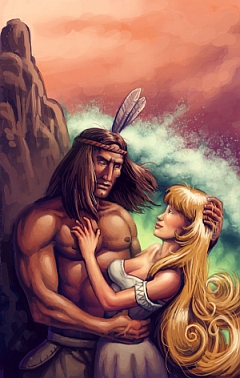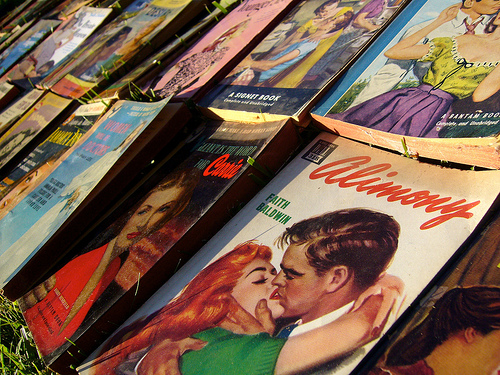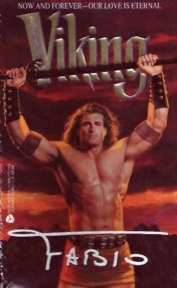Course:LIBR548F/2009WT1/The Romance Novel
The romance novel is a literary genre that developed in Britain in the 18th and 19th centuries and expanded through the 21st century in North America and the rest of the Western world. Today, the romance genre holds international appeal to women of all ages.
Definition
Romance novels are, by the most simplistic definition, stories about love. However, the modern romance genre--like any style of genre writing--has more controlled parameters than this, although a focus on a romantic relationship and a happy ending are all that is required. Romance novels are generally written by women for women and “present a love story with a central female character and a focus on that character’s emotional state”.[1] The plot is built around the relationship between the hero and heroine and the conflicts within that relationship until it reaches an emotionally satisfying ending. They are positive and optimistic, and romance readers read them to enjoy the snappy dialogue, well-crafted scenes, connection between the characters, and details of the character’s lifestyles.[2] The exact definition of a romance novel is arguable; one male critic suggests that the development of a loving relationship between the characters that triumphs against its obstacles is more crucial than the main protagonist needing to be female.[3] In opposition, a female author specifically insists on a heterosexual relationship and marriage by defining a romance novel as "a work of prose fiction that tells the story of courtship and betrothal of one or more heroines".[4]
The genre can be divided into seven main subgenres: contemporary, historical, regency, suspense, paranormal, inspirational (religious), and multicultural (mainly African American romance). Books can be either full-length fiction works or shorter ‘series’ or 'category' romances, such as those published by Harlequin and Silhouette.
History
Early Works
Histories of the genre consider Samuel Richardson's 1740 novel, Pamela, to be the first romance novel. Although the novel does not follow the exact definition of a modern romance, the story revolves around a courtship, is narrated from the heroine's perspective, and has a happy ending. However, Jane Austen is more commonly considered be the mother of the romance genre. Pride and Prejudice, published in 1813, has been called "the best romance novel ever written".[5]
The first modern romance novels were inspired by Jane Austen's works. Georgette Heyer's historical romances, which were published between 1921 and 1974, were set in the regency period (1811-1820).[6] This romance subgenre became the traditional setting for the romance novel and continues to be popular today.
Serial Romance Boom
In the 1930s, Mills and Boon began releasing romance novels in the United Kingdom; in 1957, a Canadian company, Harlequin Enterprises, began reprinting Mills and Boon novels for sale in North America.[7] The novels were short and formulaic, featuring heroines who worked in traditionally female jobs, and intimacy was limited to a kiss. In 1971, Harlequin purchased Mills and Boon and expanded their North American market.[8] Throughout the 1970s and 1980s, the number of category romance lines from various publishers increased rapidly.
The Modern Romance Novel
The modern romance genre was born in 1972 with Kathleen Woodiwiss's The Flame and the Flower, which included more graphic intimacy than ever before published; it sold 2.35 million copies.[9] This rapidly spurred growth in the industry for single-title romances. Romance novels earned the name "bodice rippers" during this period of popularity due to the suggestive nature of the cover images of these novels.
In the 1980s, contemporary romances increased in popularity and began to feature older heroines in less traditionally female jobs. In juxtaposition to a stronger female, a more sensitive "beta male" hero was used as opposed to the traditional "alpha male" hero. The relationship between the heroine and hero changed to reflect the more balanced relationship that the modern woman had come to expect in her own life.
In 1989, Jude Deveraux's A Knight in Shining Armor became the first romance author to be published in hardcover. Up to this point, romance fiction was published exclusively in paperback, which remains its primary form of publication today.[10] Librarian and romance author Jayne Ann Krentz stated that “There is no question that hardcovers have a legitimizing effect on a genre…bringing with it a degree of respect that doesn’t occur when a genre appears only in paperback”.[11]
Popular Conceptions and Critical Reception
Romance fiction is commonly called smut, trash, nurse novels, or bodice rippers; this derogatory slang reflects the stigma against the genre. Academic articles from the 1960s through the 1980s were generally scornful, focusing on the negative elements of romance, and making a clear distinction between romance and “higher" literary works. In addition, romance was often deemed pornographic for its inclusion of sex between hero and heroine, and for its focus on the heroine’s sexual satisfaction.[12] The genre has been scorned by both liberal and conservative thinkers; in the past, much of the derisive examination of the genre has come from feminist scholars. Only within the last two decades has feminist thinking embraced this genre as women's own.
Persisting negative perceptions of the genre have not stopped readers; American romance readers encompass a wide range of ages and most of those readers have some level of college or university education.[13] Romance fiction generated $1.375 billion in sales in 2007 and accounts for 59 percent of all popular paperback fiction sold in North America,[14] making romance novels the most popular books in North America.[15]
The most notable awards for the genre are the RITA Awards, given out yearly by Romance Writers of America (RWA).[16] These awards highlight the best works in romance fiction in a number of categories and subgenres, as voted on by other romance authors.
Notes
- ↑ Adkins, D., Esser, L. G., & Velasquez, D. L. (2006). Relations between librarians and romance readers: a Missouri survey. Public Libraries, 45 (4), p. 54.
- ↑ Wyatt, N., Olson, G., Ramsdell, K., Saricks, J., & Welch, L. (2007). Core Collections in Genre Studies: Romance Fiction 101. Reference & User Services Quarterly 47 (2), p. 121.
- ↑ Cawelti, John G. (1976). Adventure, Mystery, and Romance: Formula Stories as Art and Popular Culture. Chicago: University of Chicago Press, 41-42
- ↑ Regis, Pamela. (2003). A Natural History of the Romance Novel. Philadelphia, Pennsylvania: University of Pennsylvania Press, 19.
- ↑ Regis, Pamela (2003), p. 75.
- ↑ Regis, Pamela (2003), p. 34.
- ↑ Charles, John and Shelley Mosley. Harlequin Turns 60, Booklist, Vol. 106 No. 2, Sept. 15, 2009.
- ↑ Regis, Pamela (2003), p. 157.
- ↑ Wendell, Sarah & Candy Tan. (2009). Beyond Heaving Bosoms. Fireside, p. 11.
- ↑ Funderburk, A. (2004). Romance collections in North Carolina public libraries: Are all genres treated equally? Unpublished master's thesis, University of North Carolina-Chapel Hill.
- ↑ Bouricius, Ann. (2000). The Romance Readers’ Advisory: The Librarian’s Guide to Love in the Stacks. Chicago: American Library Association, p. 5.
- ↑ Adkins, D., Esser, L. G., & Velasquez, D. L. (2006), p. 45 (4), 54-64.
- ↑ Romance Writers of America (RWA). (2007). 2007 Romance-Fiction Sales Statistics, Reader Demographics and Book-Buying Habits. Retrieved September 22, 2009.
- ↑ Romance Writers of America (RWA). (2007). 2007 Romance-Fiction Sales Statistics, Reader Demographics and Book-Buying Habits. Retrieved September 22, 2009.
- ↑ Wendell & Tan (2009), p. 4.
- ↑ RITA Awards
Recommended Resources
Krentz, Jayne Ann (ed.). (1992). Dangerous Men & Adventurous Women. University of Pennsylvania Press.
Regis, Pamela. (2003). The Natural History of the Romance Novel. University of Pennsylvania Press.
Wendell, Sarah & Candy Tan. (2009). Beyond Heaving Bosoms. Fireside.


